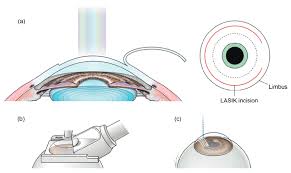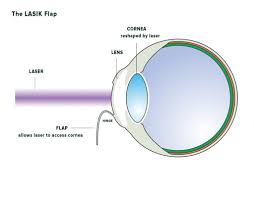Table of Contents
ToggleCongratulations on undergoing LASIK surgery! It’s an exciting journey to clearer vision and freedom from glasses or contact lenses.
However, experiencing eye pain three weeks after the procedure might be concerning.
In this comprehensive guide, we’ll delve into the possible causes of eye pain post-LASIK, what you can do about it, and when it’s time to seek professional help.

Understanding LASIK and Its Aftermath:
LASIK (Laser-Assisted In Situ Keratomileusis) is a popular surgical procedure designed to correct refractive errors like nearsightedness, farsightedness, and astigmatism.
During LASIK, a laser is used to reshape the cornea, enabling light to focus properly on the retina, resulting in clearer vision.
After LASIK, it’s common to experience some discomfort or side effects as your eyes heal and adjust to their new shape. These can include dryness, sensitivity to light, glare, halos, and fluctuations in vision. Most of these issues are resolved within the first few days or weeks after surgery. However, persistent or worsening eye pain beyond the initial recovery period warrants attention.
Potential Causes of Eye Pain Three Weeks After LASIK:
1. Incomplete Healing:
For some individuals, the healing process following LASIK may extend beyond the expected timeframe. Regenerating the intricate nerve network of the cornea takes time, and discomfort may persist until this regeneration is complete.
2. Dry Eye Syndrome:
One of the most common causes of eye pain after LASIK is dry eye syndrome. During the procedure, the corneal nerves responsible for triggering tear production can be temporarily disrupted, leading to decreased tear production and dryness.
While artificial tears and lubricating eye drops are typically prescribed to alleviate dryness, some individuals may experience persistent discomfort.
3.Corneal Abrasions or Injuries:
Although LASIK is a minimally invasive procedure, there is still a risk of corneal abrasions or injuries during surgery. These microscopic scratches on the surface of the cornea can cause pain, redness, and sensitivity to light.
While most abrasions heal on their own, severe or persistent cases may require medical intervention.
4.Inflammation or Infection:
In rare cases, eye pain after LASIK may be attributed to inflammation or infection of the cornea or surrounding tissues. Symptoms may include severe pain, redness, discharge, and vision changes.
Timely assessment and treatment by an eye care professional are vital to prevent complications and safeguard vision.
5.Underlying Eye Conditions:
Pre-existing eye conditions such as glaucoma, uveitis, or keratitis can sometimes cause or exacerbate post-LASIK eye pain. Individuals with a history of these conditions should discuss their risks and concerns with their ophthalmologist before undergoing LASIK.
What You Can Do About It:
1.Continue Prescribed Medications:
Use the medications your ophthalmologist prescribed diligently to reduce inflammation and aid healing.
2.Follow Post-Operative Instructions:
Adhering to your surgeon’s post-operative instructions is crucial for optimal healing and recovery. This includes using prescribed eye drops, avoiding rubbing or touching your eyes, wearing protective eyewear as advised, and attending follow-up appointments.
3.Use Lubricating Eye Drops:
If dryness is contributing to your eye pain, lubricating eye drops can provide relief by keeping your eyes moist and comfortable. It’s important to use preservative-free drops recommended by your surgeon and avoid products that contain ingredients that may exacerbate dryness.
4.Avoid Irritants:
Minimise exposure to potential irritants such as smoke, dust, wind, and allergens, as these can worsen eye discomfort and delay healing. Consider using a humidifier to add moisture to the air, especially in dry or arid environments.
5.Apply Warm Compresses:
If you’re experiencing discomfort due to inflammation or mild dry eye, applying warm compresses to your closed eyelids can help soothe irritation and promote tear production.
Be sure to use a clean, lint-free cloth and gently press it against your eyelids for several minutes at a time.
6.Eyelid Hygiene:
It’s important to maintain good eyelid hygiene to prevent debris accumulation and bacterial buildup, which can exacerbate irritation.
Gently clean your eyelids with a solution recommended by your doctor to ensure they stay clean and free from irritants.
7.Reduce Screen Time:
Constant exposure to digital screens can strain your eyes and worsen discomfort. Consider limiting your screen time and taking regular breaks to allow your eyes to rest.
Adhere to the 20-20-20 rule: every 20 minutes, take a 20-second break to focus on something at least 20 feet away. This practice helps alleviate eye strain and promote eye comfort.
8.Maintain a Healthy Environment:
Dry environments, especially in climates with low humidity, can exacerbate dry eyes. Using a humidifier in your living or working space can help add moisture to the air, providing relief for your eyes and reducing discomfort.
9.Light Management:
Harsh lighting conditions, both indoors and outdoors, can contribute to eye discomfort. Avoid bright, harsh lights whenever possible, and consider using dimmer or softer lighting in your surroundings.
When outdoors, protect your eyes from sunlight by wearing sunglasses with UV protection. This not only shields your eyes from harmful UV rays but also helps alleviate discomfort caused by bright sunlight.
When to Seek Professional Help:
While some degree of discomfort or fluctuations in vision is normal during the healing process after LASIK, persistent or severe eye pain should not be ignored. If you’re experiencing any of the following symptoms, it’s essential to contact your surgeon or eye care provider promptly:
– Severe or worsening eye pain
– Redness, swelling, or discharge from the eye
– Sudden changes in vision, such as blurriness or halos around lights
– Sensitivity to light (photophobia) that doesn’t improve with time
– Any other unusual or concerning symptoms
Your surgeon will conduct a thorough evaluation to determine the underlying cause of your symptoms and recommend appropriate treatment.
Importance of Communication with Your Doctor:
Maintaining open communication with your ophthalmologist is crucial during your recovery period.
If you have any concerns, or questions, or encounter any of the warning signs mentioned earlier, it’s essential to schedule an appointment promptly. Your ophthalmologist can evaluate your condition, offer personalised advice, and help ensure a seamless recovery process.
Remember: Healing after LASIK is a Journey, Not a Destination
While LASIK offers the potential for improved vision, it’s important to remember that healing is a gradual process.
Eye pain three weeks after LASIK can be distressing, but it’s essential to remain calm and proactive in addressing your concerns. By understanding the potential causes of eye pain post-LASIK and taking appropriate steps to manage your symptoms, you can promote healing and ensure the best possible outcome.
Remember to communicate openly with your surgeon or eye care provider and seek professional help if needed.
With patience and proper care, you’ll soon be enjoying the clear vision and newfound freedom that LASIK has to offer.













